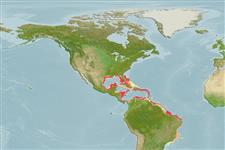>
Eupercaria/misc (Various families in series Eupercaria) >
Labridae (Wrasses) > Corinae
Etymology: Halichoeres: Greek, als, alis = salt + Greek, choiros = pig (Ref. 45335).
More on author: Bloch.
Environment: milieu / climate zone / depth range / distribution range
Écologie
marin récifal; profondeur 18 - 91 m (Ref. 7251), usually 30 - ? m (Ref. 52607). Tropical; 30°N - 33°S, 98°W - 32°W
Western Atlantic: Florida, USA and Antilles to Brazil.
Taille / Poids / Âge
Maturity: Lm ? range ? - ? cm
Max length : 30.0 cm TL mâle / non sexé; (Ref. 7251)
Épines dorsales (Total) : 9; Rayons mous dorsaux (Total) : 12; Épines anales: 3; Rayons mous anaux: 12. Juveniles and females yellow with broad blue stripe from eye to center of caudal fin. The only Halichoeres species in Caribbean region with 12 dorsal rays, all other have 11 (Ref. 26938). Adults with a broad black stripe on upper half of body; narrowing as it passes posteriorly to end in middle of caudal fin; lower half of body light blue-green; head below level of mouth blue-green, above yellow (Ref. 13442).
Found over hard substrates (Ref. 9626). Juveniles up to 8 cm act as specialized cleaners. Each individual tends a defined cleaning station sought by several species of reef fishes including damselfishes, goatfishes, and surgeonfishes. At the cleaning station this wrasse swims in a characteristic seesaw motion (Ref. 31373). Occasionally caught by anglers. Generally of no interest to fisheries because of its small average size (Ref. 5217). Found at 9 m in Belize (Ref. 26938).
Life cycle and mating behavior
Maturities | Reproduction | Spawnings | Egg(s) | Fecundities | Larves
Distinct pairing during breeding (Ref. 205).
Robins, C.R. and G.C. Ray, 1986. A field guide to Atlantic coast fishes of North America. Houghton Mifflin Company, Boston, U.S.A. 354 p. (Ref. 7251)
Statut dans la liste rouge de l'IUCN (Ref. 130435)
Menace pour l'homme
Harmless
Utilisations par l'homme
Pêcheries: commercial; pêche sportive: oui; Aquarium: Commercial
Outils
Articles particuliers
Télécharger en XML
Sources Internet
Estimates based on models
Preferred temperature (Ref.
123201): 21.1 - 27.6, mean 25.4 °C (based on 91 cells).
Phylogenetic diversity index (Ref.
82804): PD
50 = 0.5000 [Uniqueness, from 0.5 = low to 2.0 = high].
Bayesian length-weight: a=0.00955 (0.00451 - 0.02020), b=3.09 (2.92 - 3.26), in cm total length, based on LWR estimates for this Genus-body shape (Ref.
93245).
Niveau trophique (Ref.
69278): 3.6 ±0.54 se; based on food items.
Résilience (Ref.
120179): Milieu, temps minimum de doublement de population : 1,4 à 4,4 années (Preliminary K or Fecundity.).
Fishing Vulnerability (Ref.
59153): Low vulnerability (20 of 100).
Nutrients (Ref.
124155): Calcium = 52.1 [30.7, 86.4] mg/100g; Iron = 0.669 [0.392, 1.226] mg/100g; Protein = 18.3 [15.5, 20.5] %; Omega3 = 0.153 [0.097, 0.239] g/100g; Selenium = 32 [18, 57] μg/100g; VitaminA = 173 [57, 594] μg/100g; Zinc = 1.27 [0.88, 1.93] mg/100g (wet weight);
